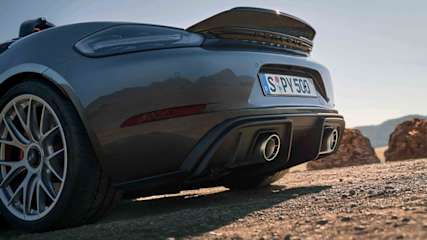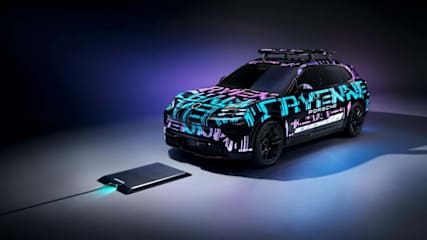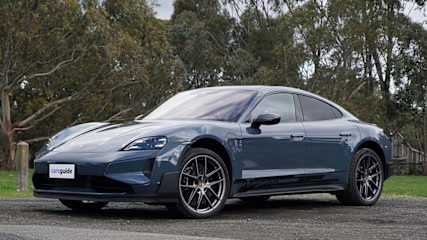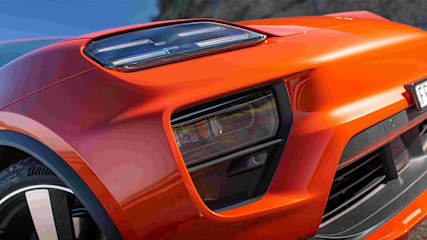Porsche 924 Reviews
You'll find all our Porsche 924 reviews right here. Porsche 924 prices range from $4,400 for the 924 to $7,920 for the 924 .
Our reviews offer detailed analysis of the 's features, design, practicality, fuel consumption, engine and transmission, safety, ownership and what it's like to drive.
The most recent reviews sit up the top of the page, but if you're looking for an older model year or shopping for a used car, scroll down to find Porsche dating back as far as 1977.
Or, if you just want to read the latest news about the Porsche 924, you'll find it all here.
Porsche Reviews and News
_0.jpg)
‘Really good feedback’: Hybrid car tech gets the tick, but will the next Porsche 911 GT3 have petrol-electric power?
Read the article
By Tim Nicholson · 25 Sep 2025
Porsche’s move into hybrid technology for its most iconic model is paying dividends, according to a key executive.

Petrol isn’t dead! Next-gen Porsche 718 will get petrol-powered versions alongside electric vehicle powertrain as German brand changes plans
Read the article
By Tim Nicholson · 23 Sep 2025
Fans of the petrol-powered Porsche 718 Cayman and Boxster sports cars have something big to celebrate.

Petrol-powered Porsche comeback hits top gear! New ‘bigger-than-Cayenne’ flagship to spearhead ICE SUV resurgence for iconic German maker. Look out Aston Martin DBX, Bentley Bentayga, BMW X7 M60i, Lamborghini Urus, Mercedes-AMG GLS63 & Range Rover SV
Read the article
By James Cleary · 23 Sep 2025
It might still be two years away from a scheduled appearance in Porsche showrooms but the German maker’s upcoming ‘K1’ upper large SUV has taken a late turn away from pure-electric propulsion to include internal-combustion (ICE) in its powertrain portfolio.
.jpg)
Sports car icon levels up with hybrid power!
Read the article
By Jack Quick · 08 Sep 2025
Porsche adds even more power to the 911 Turbo.

Game-changing new EV charging tech detailed!
Read the article
By Jack Quick · 05 Sep 2025
Porsche has detailed a new wireless charging technology for its electric vehicles (EVs) that will debut at this year’s IAA Mobility show in Munich, Germany.

Porsche 911 2026 review: Carrera Coupe
Read the article
By Chris Thompson · 23 Aug 2025
For more than 60 years, the Porsche 911 has built a reputation as the ultimate in everyday sports car driving. We grab a 'base' model Carrera to find out if the 992.2 generation still lives up to the hype.

Porsche Taycan 2026 review: Turbo GT
Read the article
By Jack Quick · 15 Aug 2025
There's quick and then there's the Porsche Taycan Turbo GT. With a starting price of around $420,000 before on-roads and options, this flagship EV offering is an exercise in over-the-top styling and outrageous pace.

Why this is the Goldilocks of engines: Why do supercars from the Bentley Flying Spur and Lamborghini Temerario to the McLaren 750S and Mercedes-AMG GT63 rely on the 4.0-litre twin-turbo V8? | Analysis
Read the article
By James Cleary · 08 Aug 2025
I’m okay with picking pattern progressions, but begin to fall short when the pressure of upper level IQ testing starts to bring me undone. That said, even I could detect the clear sequence of super performance carmakers following one another into the world of the 4.0-litre, twin-turbo V8.A slew of British, German and Italian brands using the same performance vs consumption vs emissions equation to propel their exotic machines towards the horizon at warp speed with maximum efficiency.So, why did white-coated boffins from all points of the automotive globe come up with the same engine configuration, capacity and induction answer?Well, at the recent global launch of the Lamborghini Temerario (a 4.0L twin-turbo V8 hybrid) we asked Lambo’s Chief Technical Officer (and drift king) Dr. Rouven Mohr exactly that.He confirmed the broadly accepted answer that an individual cylinder volume of 500cc is the magic number.That’s right, the capacity that took the ‘Wollongong Whiz’ Wayne Gardner and ‘The Master of going Faster’ Mick Doohan to 500cc World Motorcycle Championship glory is the Goldilocks zone for an individual engine cylinder. And that’s because a cylinder of that size, ideally undersquare (with a stroke length exceeding its bore diameter), optimises the combustion process thanks to a relatively small internal surface to volume ratio (as the piston nears top dead centre) which helps improve fuel efficiency while producing optimum power and minimising C02 and NOx emissions.So, 500 times eight equals 4000, which, with the benefit of forced induction pushes the golden ratio to its maximum.And Lamborghini should know because the all-new (L411) unit it developed for the Temerario produces 588kW on its own, before a trio of electric motors tips in another 89kW for a total output of 677kW (920hp).Two turbos producing 2.5 bar located in the engine’s ‘hot vee’ optimise packaging and thermal management; titanium conrods reduce rotating mass; a flat plane crank delivers an even firing order and super hard finger followers in the valvetrain allow more aggressive cam profiles. The result? A 10,000rpm rev ceiling, which is… nuts.Other brands within the Volkswagen Group portfolio are on the same train, like Audi’s SQ7 and SQ8 with Bentley and Porsche directly sharing engine tech.And what about Mercedes-AMG with the GT63 and SL63 or McLaren just about matching Lambo for specific power output with its 750S rocketship?But hands up those who remember JLR’s ‘Ingenium’ modular engine family. Three-, four- and six-cylinder units built around 500cc cylinders. BMW Group with its triple, four- and six-cylinder engines, along with many others have also struck on the 500cc formula. But maybe Lamborghini President and CEO Stephan Winkelmann has the most compelling reason for joining the club.While acknowledging the capacity of the cylinder premise - “Six cylinder is usually three litres, eight is four and 12 is six” - he lets slip that the 4.0L thing “is also a matter of taxation in a lot of countries”. So, follow engine efficiency or follow the money, the 4.0-litre, twin-turbo V8 answer is the same.
.jpg)
Ultimate EV backflip confirmed! Petrol-powered Porsche Macan SUV to return as EV-only plans for 2026 Audi SQ5, Genesis G70 and Lexus NX rival falter
Read the article
By Tom White · 05 Aug 2025
Petrol power is returning to the Porsche Macan

Huge Australian electric car myth busted: What we learnt driving from Melbourne to Sydney in a 2026 Porsche Macan electric SUV | Opinion
Read the article
By Stephen Ottley · 02 Aug 2025
Electric cars aren’t built for Australia and a country of its size. It is too big and electric vehicles (EVs) simply don’t have enough range to get you across this wide, brown land.Or, at least that’s what we’ve been told by the naysayers for the past decade or so. They decry the limited capacity of batteries and the lack of infrastructure as reasons why EVs will never be successful in Australia.But is that actually true? To put those criticisms to the test I decided to do the only logical thing: drive one of Australia’s most popular long-distance journeys in an EV to see if I could make it. So I drove the new Porsche Macan RWD from Melbourne to Sydney in a single day to test the reality of long-range EV driving. And these are the lessons I learnt.It’s perhaps the most common phrase associated with EVs and their detractors, range anxiety - the idea that you’ll run out of charge and be stranded. The truth is modern EV batteries have reached a state where they can offer enough range to make the drive between Melbourne and Sydney on surprisingly few stops.The official claimed range of the Macan RWD is 653km, but that’s a lab test so not representative of what you’ll get in the real world. Instead, on our drive the Macan was capable of hitting approximately 500km on a single charge.Now the haters will say that’s 153km less than claimed, but that overlooks the fact that very few internal combustion engine vehicles hit their official claimed fuel consumption figures either.It also overlooks the fact that 500km is a significant range, with the distance between Melbourne and Sydney less than 900km via the most direct route. And on the route there is a steady string of EV chargers up and down the highway. The notion that EV charging infrastructure is lacking was one of the biggest misconceptions my trip cleared up. There are chargers in freeway-side service centres and in small towns (more on that later) so you’re never really more than 200km from any charger. Sure, there’s more fuel pumps, but given the percentage of EVs making such large trips the current infrastructure seems more-than-adequate.While we’re on the top of EV range, for my particular drive between our two biggest cities I drove a Macan with a factory-developed roof box, while the camera car that joined me was stock (no roof box). There was an expectation that the roof box would impact the driving range, but it was surprising just how much impact it had.If you’ve wondered why car makers are trying to make pop-out door handles and digital side mirrors common on EVs it’s because it all makes a difference. Despite the factory-designed aerodynamic shape of the roof box it still knocked off around 20-25% driving range compared to the camera car. Obviously that’s a significant drop, but as long as you are aware of what impact adding extras to your EV is you can compensate accordingly.When I say you can ‘compensate accordingly’ I mean that, as mentioned earlier, there’s no shortage of chargers and many of them are located in some of Australia’s most beautiful, but largely forgotten, small towns.For example, we took a detour off the freeway into Beechworth, the small Victorian hamlet that’s home to famous honey and one of Australia’s most renowned bakeries. It’s the perfect place to stop and recharge the car - as well as recharge the driver and passengers.While there are plenty of service centre chargers, I was surprised by the amount of small towns, long since bypassed by the freeway, that have installed chargers. Holbrook and its submarine, the geographical halfway point in Tarcutta and even the Dog on the Tuckerbox at Gundagai all have places to stop and charge.Another regular criticism of electric cars is the time it takes to recharge the batteries. Obviously it takes longer than refuelling a petrol or diesel tank, which is a major turn-off for many. But unless you’re in a really big hurry to get to your destination, it shouldn’t be.Obviously it’s a good idea to ‘stop, revive, survive’ on any long trip and modern EVs are capable of reaching 80 per cent battery capacity in a relatively short period of time. The final 20 per cent takes longer, but even then it’s not exactly a drag.On my road trip the longest stop, which was to get as close to 100 per cent as possible, lasted about 30 minutes. Generally the 80 per cent top-ups took around 20 minutes, which turned out to be a handy amount of time to stretch the legs, use a bathroom and grab something to eat.If you are like me and prefer to enjoy a relaxed road trip, charging actually fits in rather nicely and makes the experience of long-distance EV driving surprisingly easy.Was driving an electric car between Melbourne and Sydney easy? In a word, yes. So much so that I’d have no worries doing such a trip again, the idea of range anxiety and sub-par infrastructure are no longer a concern based on my real-world experience.I still understand that for some, those in a hurry or just aggressively anti-EV, it will still sound unappealing and stressful, but I would encourage any EV owner who has avoided long journeys to take the leap and head out of town for an electric road trip.




